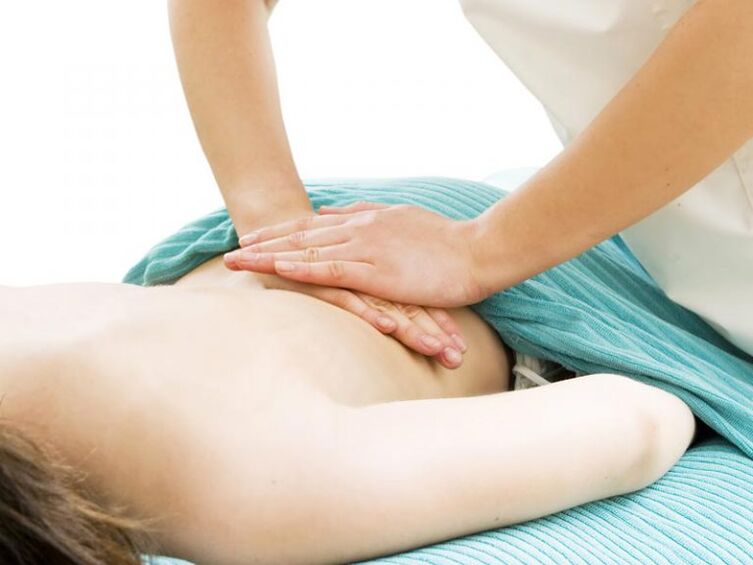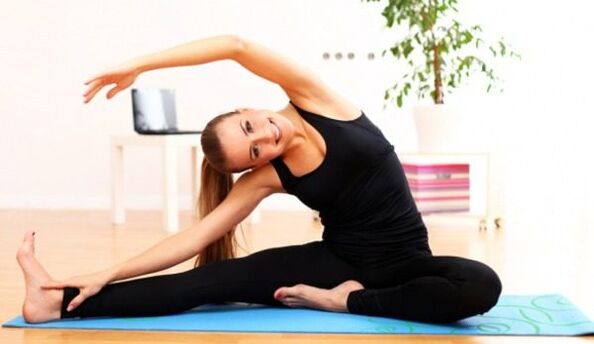Osteochondrosis of the lumbar region is a common disease.This is a consequence of the degenerative process in which the intervertebral album suffers: tissue nutrition worsens, the disc is thinner, hardens and does not perform the shock absorption function.As a result, the distance between the vertebrae decreases, and the ends of the spinal cord and the nerves are pinched, the dysfunction of pain and organs occurs.
The intervertebral disc is an anatomical disk form that provides mobility and elasticity of the spine.The album consists of an octopoose core surrounded by a fibrous ring.The octopoe nucleus absorbs rapidly and provides water, which is important to maintain intra -discarded pressure.All degenerative discourage diseases of the column, which include osteochondrosis, begin with gradual dehydration of the octopoose nucleus.
Causes of lumbar osteochondrosis
Lumbar osteochondrosis develops as a result of a series of reasons:
- Regular high load in the lower back.At risk, athletes and people who are forced to lift weights at work.
- A sedentary lifestyle.Without moderate physical activity, the muscle corset weakens, the blood circulation worsens and the metabolic processes in the column slow down.
- Overweight.The consequences of overweight: an increase in the pressure in the spinal column, the premature wear of the intervertebral discs.
- Moster disorders.With a hunched back or excessive deflection in the lower back, the back muscles are weak or vice versa.The load in the column is distributed unequally.
- The spine of trauma and microtrauma.They can cause sports, especially without adequate preparation, incorrect weightlifting, bruises, falls, etc.
When we lift weights, the following procedure must be observed:
- Squat, correct;
- Take the load as close as possible to the body;
- When raising in the first place, you must hang your leg muscles (feet, hips);
- Then place the press;
- Finally, the muscles of the hands begin to work.
- Age.The dystotic changes in the spine are part of the aging process, but now such a diagnosis is made more and more in faces of 25-30 years and even adolescents.
- Inheritance.Violations in the development of the musculoskeletal framework and the weak structure of intervertebral discs can be genetically predetermined.
- Inflammatory diseases of the spine.Infections and diseases that cause inflammation of the spine joints, changes in their structure and shape can cause the development of osteochondrosis.
Other causes provocative of lumbar osteochondrosis:
- congenital or acquired violations in the structure of the skeleton;
- frequent hypothermia;
- high level of stress;
- incorrect nutrition;
- violation of the day regime;
- possess uncomfortable for a long time;
- Failure in the endocrine system;
- diseases of other organs;
- Bad ecology.
Stages of Lumbar Osteochondrosis
The lumbar column osteochondrosis develops gradually, through four stages.
The first stage is the beginning of the degenerative process in the spine.The rare silly pain in the lower back, which manifests especially when lifting weights or uncomfortable movements are characteristic.
In the second stage, the fibrous ring of the album is destroyed and the vertebrae is joined, the nerve endings of the spinal cord is compressed.The pain becomes hard, it occurs even with ordinary walks.
In the third stage, fibrous rings are finally destroyed, intervertebral hernias appear.Intensive pain is constantly feeling, regardless of the load and nature of the movements.
In the fourth stage, the cartilage is stunted, and the bone tissue of the vertebrae in the lumbar region grows, thus adapting to pain.The lumbar region loses flexibility, it is difficult for the patient to move, disability may occur.
Lumbar osteochondrosic symptoms
Lumbar osteochondrosis develops slowly, in the early stages, its symptoms express themselves weakly, they are rarely manifest and only after excessive or atypical load.Therefore, many do not give them any importance.As a general rule, the disease is diagnosed only in the second stage.
Symptoms are divided into the following types:
- Lumbalgia: painful pain in the lumbar region, which constantly lasts.It is improved by inclinations, turns, physical activity and hypothermia.Relief gives him rest behind his back, so the patient is forced to be more at home.
- Lumbago: acute and intense pain, as a "change."To protect themselves from him, back muscles are refressed reflexively in a spasm, an involuntarily takes a safe hold.With any movement, the pain intensifies, radiates to the organs of the pelvis, the area of the sacrum and the abdomen.If such symptoms are observed, it is recommended to rest in bed.
- Lumbosiciashyalgia: pain with the propagation to the buttocks, one or both legs.The sensitivity of the lower extremities is changing, both in the largest and smaller direction, depending on which column it is pinched.The lower the location of the degenerative changes, the lower the symptoms in the legs: the mobility of the muscles and the reflexes of the tendons will decrease, the sensations of cold or heat, burned, tingling, numbness will appear.
Osteochondrosis is a chronic disease, which periodically goes to an acute and subacute stage.The pain in the acute stage can last several weeks.
During the disease, the symptoms can occur in the complex, the following syndromes occur:
- Rook syndrome.Nervous endings (roots) are tightened by vertebrae, in an area associated with the affected nerve, pain appears.The body tries to protect the nerve, tense muscles, change the posture (biased on the opposite and healthy side).
If the treatment does not begin to start treatment on time, after the irritation of the roots, its inflammation will continue, accompanied by edema, blood stagnation and even poisoning.The tone of the muscles is reduced, the patient can barely move.If the spinal cord is compressed, paralysis occurs.
- Ischemic syndrome.These are symptoms associated with circulatory disorders.The squeezed arteries lead to pain, especially during the walk.The whole leg hurts from the buttock to the foot, the pelvic organs do not receive adequate nutrition, as a result: their function is interrupted.
- Vertebrate syndrome.The previous syndromes lead to the fact that the shape of the spine changes.Due to constant pain and weakened muscles, distortions of the spine appear.
Treatment methods
The treatment of the osteochondrosis of the lumbar region must be carried out in an integral way.The main treatment tasks:
- Elimination of pain syndrome in the lumbosacro department;
- elimination of muscle tension;
- Elimination of the causes of root and ischemic syndromes;
- stimulation of the restorative forces of the body;
- Strengthen the motor device at the bottom of the body.
Drug treatment
Acute phase medications are designed to relieve the main symptoms: pain, inflammation, roots clamping.For these purposes, non -steroidal anti -inflammatory medications, muscle relaxants, glucocorticoids, blocking are used.Pharmacological treatment is generally used in combination with other procedures.

Massage
Professional massage is one of the best methods to treat column diseases.It can be carried out both in the clinic and at home.During massage, tissue nutrition is restored, muscle cramps and pain are maintained.The masseuse must have high grades, since inappropriate actions can aggravate the patient's condition, especially during exacerbation.
Physiotherapy
Physiotherapeutic procedures contribute to pain elimination, muscle relaxation, blood vessel expansion.The most effective procedures: electrophoresis, ampulse, exposure to UV rays, phonoforesis, darsonvalization, magnetotherapy, acupuncture, etc.Some devices can be purchased for use at home.
Medical Physical Education
Exercise therapy is mainly prescribed during the referral period, less frequently in the acute stage.The exercises are selected individually, taking into account the characteristics of the course of the disease.They are best done in a medical institution under the supervision of a specialist, but it is possible at home.
Traditional medicine
Popular remedies help relieve pain and improve blood circulation.Apply several decoctions, infusions, ointments, compresses.Of medicinal plants, lingonberries, birch, gross, sage, banana and many others are used.There are hundreds of recipes, but you must remember that only a doctor can give recommendations on how to deal with lumbar osteochondrosis at home.
Surgical treatment
If other treatment methods have not brought the result, and the patient's condition is exacerbated, then surgeon surgery is necessary.During surgery in the spine, disc hernias are eliminated and vertebral plastic is manufactured.
Do not try to choose medications or exercises at home, this can lead to unpredictable consequences.
Prevention of lumbar osteochondrosis
So unpleasant symptoms of column problems during life do not appear, certain rules must be observed:

- Avoid a strong load on the back, if there is such need, use a corset;
- Daily, gymnastics at home or in the gym, leads an active lifestyle;
- maintain adequate posture;
- walk on foot every day;
- Not being in a position sitting for a long time;
- During the day, relax periodically lying on his back;
- Observe the daily routine;
- abandon smoking and alcohol;
- Eat correctly, monitor the weight;
- Treat other back diseases over time.
Products that allow us to strengthen bones and avoid the development of column pathologies:
- Sea fish.
- Olive, flaxseed oil.
- Natural dairy products.
- Gelatin (as part of the dishes, for example, in a cold or jelly).
- Cartilage cartilage.
- Fresh fruits, vegetables.
- Green.
- Mineral water.
- Mineral vitamin special complexes.
Osteochondrosis of the lumbar region can seriously complicate life.The non -reversible changes in the spine will sooner or later lead to a sensation of pain and limiting mobility.In order not to lose the ability to move freely and work completely, it is important from an early age to participate in the rehabilitation and strengthening of the back.If the first symptoms of osteochondrosis appear, in no case a visit to a doctor.Only qualified and with the time borrowed assistance will allow maintaining the health of the spine.



































